DevOps Sessions - Week 20 - Conclusion & Appreciations
devops 12-12-2024

DevOps Sessions - Week 20 - Conclusion & Appreciations
Welcome to the final week of our “Becoming a DevOps Engineer” series! First of all, I would like to thank you for following this series. I hope you have learned something new and useful. I would also like to extend my gratitude to everyone who contributed to this series, especially to all the viewers who have been following along. It has been a great journey to share my knowledge with you all, and I hope you have enjoyed it as much as I did sharing.
Session Overview
1. Recap of the Series
- Introduction to DevOps
- Version Control System
- Continuous Integration
- Continuous Deployment
- Infrastructure as Code
- Configuration Management
- Monitoring and Logging
- Containerization
- Orchestration
- Security
- Well Architected Framework
2. Key Takeaways
- Core Principles of DevOps
- Tools and Technologies
- Best Practices
- Real-World Applications
3. Future Directions
- Continued Learning
- Emerging Trends
- Community Engagement
4. Closing Remarks
- Thank You Note
- Encouragement for Future Endeavors
1. Recap of the Series
Over the past 20 weeks, we have covered a wide range of topics essential to becoming a proficient DevOps engineer. Let’s briefly revisit each of these topics:
Introduction to DevOps
We started with the basics, defining DevOps and understanding its core principles, such as collaboration, automation, and continuous improvement. We explored how DevOps bridges the gap between development and operations teams, fostering a culture of shared responsibility and rapid iteration.
Version Control System
We delved into version control systems, focusing on Git. We learned how to track changes, collaborate on code, and manage branches and merges, ensuring a seamless workflow in a team environment.
Continuous Integration
Continuous Integration (CI) introduced us to automated testing and integration processes. We explored tools like Jenkins and GitLab CI/CD to automate the build and testing phases, ensuring code quality and reducing integration issues.
Continuous Deployment
Continuous Deployment (CD) extended CI by automating the deployment process. We discussed deployment strategies, including blue-green deployments and canary releases, and explored tools like Jenkins, GitHub Actions, and AWS CodePipeline.
Infrastructure as Code
Infrastructure as Code (IaC) transformed how we manage infrastructure. We learned about tools like Terraform, AWS CloudFormation, and Pulumi, which allow us to define, provision, and manage infrastructure through code.
Configuration Management
Configuration management tools like Ansible, Puppet, Chef, and SaltStack helped us automate the configuration and management of servers, ensuring consistency and compliance across environments.
Monitoring and Logging
We explored monitoring and logging practices essential for maintaining the health and performance of applications. Tools like Prometheus, Grafana, ELK Stack, and Datadog provided insights into system performance and facilitated troubleshooting.
Containerization
Containerization with Docker revolutionized how we build, ship, and run applications. We learned about creating Docker images, managing containers, and using Docker Compose for multi-container applications.
Orchestration
Orchestration with Kubernetes and Docker Swarm enabled us to manage containerized applications at scale. We discussed concepts like container scheduling, scaling, and self-healing.
Security
Security, or DevSecOps, integrated security practices into the DevOps process. We covered key practices like shift-left security, continuous security monitoring, and vulnerability management, along with tools like OWASP ZAP, HashiCorp Vault, and Snyk.
Well Architected Framework
The Well-Architected Framework provided a structured approach to building secure, high-performing, resilient, and efficient cloud architectures. We explored the six pillars: Operational Excellence, Security, Reliability, Performance Efficiency, Cost Optimization, and Sustainability.
2. Key Takeaways
Core Principles of DevOps
- Collaboration: Foster a culture of collaboration between development and operations teams.
- Automation: Automate repetitive tasks to increase efficiency and reduce errors.
- Continuous Improvement: Continuously iterate and improve processes and practices.
Tools and Technologies
- Version Control: Git, GitHub, GitLab.
- CI/CD: Jenkins, GitHub Actions, GitLab CI/CD, AWS CodePipeline.
- IaC: Terraform, AWS CloudFormation, Pulumi.
- Configuration Management: Ansible, Puppet, Chef, SaltStack.
- Monitoring and Logging: Prometheus, Grafana, ELK Stack, Datadog.
- Containerization: Docker, Docker Compose.
- Orchestration: Kubernetes, Docker Swarm.
- Security: OWASP ZAP, HashiCorp Vault, Snyk.
- Well-Architected Framework: AWS Well-Architected Tool.
Best Practices
- Automate Everything: From testing to deployment, automate as many processes as possible.
- Security by Design: Integrate security into every phase of the DevOps lifecycle.
- Monitor Continuously: Implement continuous monitoring to ensure system health and performance.
- Optimize Costs: Regularly review and optimize resource usage to reduce costs.
Real-World Applications
- CI/CD Pipelines: Streamline the software delivery process with automated CI/CD pipelines.
- IaC: Manage infrastructure at scale with code.
- Containerization and Orchestration: Deploy and manage containerized applications efficiently.
- Security: Ensure compliance and protect sensitive data with integrated security practices.
3. Future Directions
Continued Learning
DevOps is an ever-evolving field. Stay updated with the latest trends, tools, and best practices by following industry blogs, attending conferences, and participating in online communities.
Emerging Trends
- GitOps: Managing infrastructure and applications using Git as the single source of truth.
- AIOps: Leveraging artificial intelligence to enhance IT operations.
- Serverless: Building and deploying applications without managing infrastructure.
- Edge Computing: Bringing computation and data storage closer to the location where it is needed.
Community Engagement
Join DevOps communities, contribute to open-source projects, and share your knowledge and experiences. Engaging with the community helps you stay connected and learn from others.
4. Closing Remarks
Thank You
Thank you for following this series. It has been a pleasure sharing my knowledge and experiences with you. I hope you have learned valuable insights and skills that will help you on your journey to becoming a DevOps engineer.
Encouragement for Future Endeavors
Keep learning, experimenting, and improving. The DevOps journey is continuous, and there are always new challenges and opportunities to explore. Embrace the DevOps culture, and you will make a significant impact on your team’s productivity and the quality of your applications.
This concludes our “Becoming a DevOps Engineer” series. We have covered a wide range of topics over the past 20 weeks, and I hope you feel more confident and equipped to implement DevOps practices in your organization. Thank you for joining me on this journey. Stay curious and keep building!

